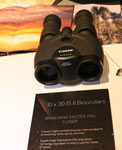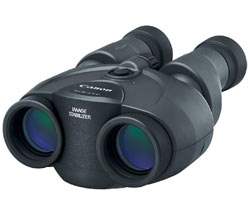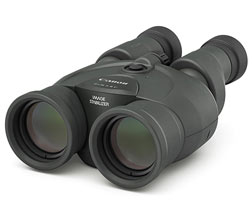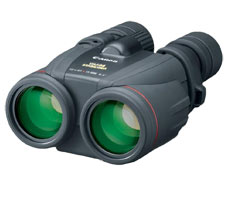Best Rated Image Stabilized (IS) Binoculars 2025 | Comparison and Reviews
January 15, 2025 by SmartReview
Filed under Best Rated Binoculars

![]()
Most IS Binoculars run on AA batteries to power the motors to compensate for vibration. All image stabilized binoculars are weatherproof, and many are waterproof as well. They are best suited for birding, boating, astronomy, and other uses. Below are the best image stabilization binoculars to compare features, reviews, and price.
(best rated IS binoculars by consumer reviews)
| Canon 10×30 | Canon 12×36 | Canon 10×42 L | Canon 15×50 | |||
|
|
| Is this the best price? | |||
| 10×30 Image Stabilized (IS) Water-resistant Uses 2xAA batteries Apparent field of view 60° Vari-Angle Prism Stabilizer Closest focus: 13.8 ft Eye Relief: 14.5mm Weight 22 oz | 12×36 Image Stabilized (IS) Water-resistant Uses 2xAA batteries Apparent field of view 60° Vari-Angle Prism Stabilizer Closest focus: 19.7 ft Eye Relief: 14.5mm Weight 23.3 oz | 10×42 L Image Stabilized (IS) Water-proof Uses 2xAA batteries Apparent field of view 65° Vari-Angle Prism Stabilizer Closest focus: 8.2 ft Eye Relief: 16mm Weight 36.8 oz Ultra-low Dispersion (UD) lens elements | 15×50 Image Stabilized (IS) Weather-Resistant Uses 2xAA batteries Apparent field of view 67.5° Vari-Angle Prism Stabilizer Closest focus: 19.7 ft Eye Relief: 15mm Weight 41.6 oz Ultra-low Dispersion (UD) lens elements | |||
| | ||||||
(best rated IS binoculars by consumer reviews)
| Canon 18×50 IS Binoculars | Sig Sauer ZULU6 16x42mm IS | Fujinon Techno-Stabi 14×40 | Sig Sauer ZULU6 10x30mm IS |
| Is this the best price? | Is this the best price? | Is this the best price? | Is this the best price? |
| 18×50 Image Stabilized (IS) Weather-Resistant Uses 2xAA batteries Apparent field of view 66.6° Vari-Angle Prism Stabilizer Closest focus: 19.7 ft Eye Relief: 15mm Weight 41.6 oz Ultra-low Dispersion (UD) lens elements | 16×42 Image Stabilized (IS) Water and Fog Proof Uses 1 AA batterys Real field of view 3.8° Schmidt-Pechan Prism Stabilizer Closest focus: 26.9 ft Eye Relief: 15mm Weight 20 oz LENSARMOR coating | 14×40 Image Stabilized (IS) Water and Fog Proof Uses 4xAA batteries Apparent field of view 52.1° Dual Piezo-vibration & Gyro Sensors Closest focus: 16.4 ft Eye Relief: 13mm Weight 43.3 oz | 10×30 Image Stabilized (IS) Water and Fog Proof Uses 1 AA batterys Real field of view 5.2° Schmidt-Pechan Prism Stabilizer Closest focus: 26.9 ft Eye Relief: 15mm Weight 18.6 oz LENSARMOR coating |
| | |||
| Binoculars Glossary of Terms |
| Image Stabilized (IS) Binoculars = These type of binoculars use Image stabilization, just like DSLR lenses have. Instead of a blurry image caused by your hand shaking, or a moving boat, you get a rock solid clear image. The optics in these stablized binoculars move to compensate for shake. The higher your magnification, the more the need for image stabilization. Closest Focus Distance = This is the nearest object that you can focus on. Lower power binoculars can focus on closer objects than high power binoculars. Apparent field of view = Apparent field of view is the angular diameter, expressed in degrees (°), of the circle of light that the eye sees through your binoculars. A large field of view is good for a seeing a large amount of area (usually with lower power binoculars). Higher power binoculars zoom in on a smaller area. Eye Relief = Eye relief is the distance (in millimeters) that a binocular can be held from your eye and the full field of view can still be observed. More Eye relief distance is important for those that wear eyeglasses. Apparent Field of View = This refers to how much of the overall scene you can view. The higher the magnification, the smaller field of view. Just like a wide angle lens will show more of the view, a lower magnification binoculars will show more of the overall scene. A higher magnification will show a closeup view, but with a much narrower field of view. The field of view is measured in degrees. A 180 degree field of view is being able to view everything in front of you. Ultra Low Dispersion (UD) Lens = Some of Canon’s high end Image Stabilized Binoculars have a superior UD Lens. These type of lenses will reduce chromatic aberration, or color fringing, which can affect the image by reducing contrast, and image sharpness. |
Related Article: Best Rated Waterproof Binoculars – Comparison & Reviews
Related Article: Smart-Review: Binoculars Buying Guide




